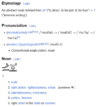Back with the Suugo linguistics (Pt.2).
Mahad (Gratitude/Appreciation) = Ma'at (Truth/Balance/Order) ????

 en.wikipedia.org
en.wikipedia.org
"The significance of Maat developed to the point that it embraced all aspects of existence, including the basic equilibrium of the universe, the relationship between constituent parts, the cycle of the seasons, heavenly movements, religious observations and good faith, honesty, and truthfulness in social interactions."
We act in good faith and maintain honesty by acknowledging and being appreciative (mahad) of the actions of others who do good towards us.
@Maakhri2024 what do you think? If you don't mind, I would love to be provided with a color coded analysis.
Mahad (Gratitude/Appreciation) = Ma'at (Truth/Balance/Order) ????

Maat - Wikipedia
"The significance of Maat developed to the point that it embraced all aspects of existence, including the basic equilibrium of the universe, the relationship between constituent parts, the cycle of the seasons, heavenly movements, religious observations and good faith, honesty, and truthfulness in social interactions."
We act in good faith and maintain honesty by acknowledging and being appreciative (mahad) of the actions of others who do good towards us.
@Maakhri2024 what do you think? If you don't mind, I would love to be provided with a color coded analysis.



